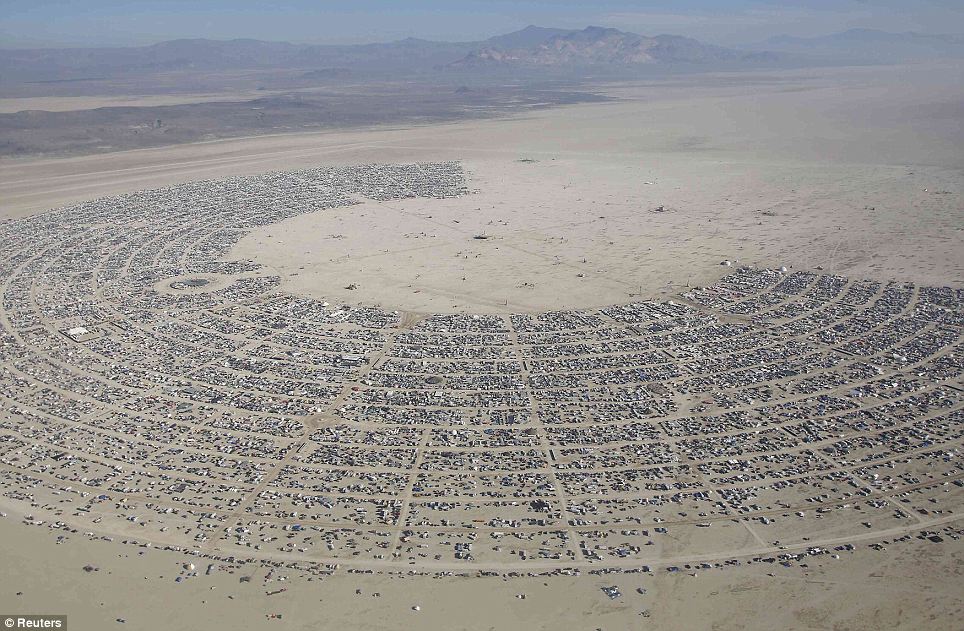 And now it’s time…the main event. Burning Man. This was my 5th “Burn” and the more often I get asked, “What is Burning Man?” the more at a loss for words I am. When you ask that question to one of the 65,000+ “Burners,” you’ll get 65,000+ different answers.
And now it’s time…the main event. Burning Man. This was my 5th “Burn” and the more often I get asked, “What is Burning Man?” the more at a loss for words I am. When you ask that question to one of the 65,000+ “Burners,” you’ll get 65,000+ different answers.
“It’s an art festival.”
“It’s the biggest party on Earth.”
“It’s a big family reunion.”
Burning Man is such a complex phenomenon that it really defies concrete description, so if I have a phone or computer nearby when someone asks me, I let Dr. Seuss explain it for me in 7 minutes: (Parents, please view before showing to kids.)
Theodor Seuss Geisel would have loved Burning Man, because it is a world unto itself, where adults become kids, and kids see a world that actually makes sense to them for the first time.
When I am further pressed for a concrete explanation of Burning Man, I usually say something to this effect: “Burning Man is when 65,000 people go into the desert in Nevada and build a utopian city (in which everything is free) that exists for only one week. Inside the city they build the most spectacular art and fanciful machines, and they live for a week as humans are intended to live: in peace and harmony, celebrating each others’ differences (not just tolerating them), and connecting with each other without the pretense and decorum and formality that keeps humans apart in the outside or ‘default’ world. At the end of the week, they burn it all to the ground, art included, and disappear, leaving no trace that they were ever there. Then they go home, and start preparing to do the exact same thing again next year.”
This post will be about Burning Man 2013 at large. The next post will be specifically about my camp, Camp Potluck, and what we do to contribute to the Burning Man community.
My partner came to Burning Man for the first time this year. He was nervous. *I* was nervous. He’s not a big camper. (Though camping at Burning Man is definitely luxurious camping.) He likes to stay clean. (We have a shower, but the event takes place in the dustiest place on Earth.) He likes to sleep at night. (Burning Man thunders 24 hours a day.) He’s not a huge people person. (People at Burning Man walk right into your camp, sit down, put their arm around you, and start talking like they’ve known you forever.) But I knew that the city, the people, and the art would be such a powerful inspiration for his photography that he just had to come.
 Within moments of his arrival, we struck out to explore the city and were immediately caught in a bee parade. What’s a bee parade, you ask? Why, a spontaneous parade of people and machines that look like bees. And a few other folks who think that sounds like fun and they’ll tag along, too, thank-you-very-much. Where are they headed? Who knows? Where did they come from? Also a bit of a mystery, because there’s a LOT of them. But it’s 6:47pm on Wednesday, August 28, and someone decided it was time for a bee parade. A perfect, incongruous, nonsensical, fantastic distillation of Burning Man.
Within moments of his arrival, we struck out to explore the city and were immediately caught in a bee parade. What’s a bee parade, you ask? Why, a spontaneous parade of people and machines that look like bees. And a few other folks who think that sounds like fun and they’ll tag along, too, thank-you-very-much. Where are they headed? Who knows? Where did they come from? Also a bit of a mystery, because there’s a LOT of them. But it’s 6:47pm on Wednesday, August 28, and someone decided it was time for a bee parade. A perfect, incongruous, nonsensical, fantastic distillation of Burning Man.
The event is called Burning Man, but the city itself is called Black Rock City, named after the desert where the ephemeral city exists for a week each year. When it exists, it’s the 3rd largest city in Nevada, behind Vegas and Reno. And it is large:
 The city is laid out in an arc centering on “The Man,” a giant statue. The inner street, Esplanade, is just shy of 2 miles long from end-to-end. Each successive street gets longer, until the outer street, L or “Laissez-faire” (the street names change each year to correspond with the theme) is 4.25 miles long from end-to-end. So you’ve got a total of 12 residential streets, totaling over 35 miles…all packed with exciting theme camps, art, and activities to explore and enjoy. Combine this with the central open area around The Man, which is filled with art, and then the vast emptiness of “Deep Playa” where massive art installations live (along with rogue, spontaneous art), and you’ve got a city that’s far too large to see in a week. Then you’ve got a big fat schedule of events hosted by theme camps nearly 200 pages thick, and that’s not even a fraction of them. (The rest can be downloaded onto an app if you’d like to see them all.) And after 7 days…it’s over. And it’s never the same again the next year. So at some point you have to throw your hands up and just resolve yourself to experiencing what you stumble across, rather than trying to soak it all in.
The city is laid out in an arc centering on “The Man,” a giant statue. The inner street, Esplanade, is just shy of 2 miles long from end-to-end. Each successive street gets longer, until the outer street, L or “Laissez-faire” (the street names change each year to correspond with the theme) is 4.25 miles long from end-to-end. So you’ve got a total of 12 residential streets, totaling over 35 miles…all packed with exciting theme camps, art, and activities to explore and enjoy. Combine this with the central open area around The Man, which is filled with art, and then the vast emptiness of “Deep Playa” where massive art installations live (along with rogue, spontaneous art), and you’ve got a city that’s far too large to see in a week. Then you’ve got a big fat schedule of events hosted by theme camps nearly 200 pages thick, and that’s not even a fraction of them. (The rest can be downloaded onto an app if you’d like to see them all.) And after 7 days…it’s over. And it’s never the same again the next year. So at some point you have to throw your hands up and just resolve yourself to experiencing what you stumble across, rather than trying to soak it all in.
Before and after the city exists each year, this is what it looks like:
This is the wilderness, folks. The bed of an ancient lake, dried up many thousands of years ago. There’s no electricity. No plumbing lines. Everyone brings what they need to survive. And then some. And when the event is over and everyone is gone, a government agency sweeps the footprint to look for trash. The last several years, the amount they’ve found has fit, it its entirety, into a gallon-sized ziploc bag. Talk about leaving no trace…
The art is the first thing that comes to mind when Burners think about Burning Man. Oh, the art! Burning Man is one of the largest contemporary art collections in the world, but only its participants get to experience it, for most of the art is burned to the ground during the event. Tragedy? So say some. But others see it as incredibly powerful that things of such potent beauty exist to be enjoyed only by a handful of appreciative, receptive eyes, and then vanish forever.
This is “Truth is Beauty.” It is the second massive female nude sculpture by artist Marco Cochrane to exist at Burning Man. Cochrane is doing a series of 3 sculptures here, and I will never forget his first one…”Bliss Dance” in 2010:
 In 2010, I saw Bliss Dance far out on the horizon in Deep Playa. I knew nothing about it. I walked toward it for what seemed like hours, and it kept getting bigger and bigger. It was so graceful and smooth, and when I took the last few steps and finally stood under her outstretched foot, I saw that she was made of sharp metal bars, with coils of razor wire for her hair…she stared down at me from the bliss of her graceful, yet somehow desperate and furious dance…I sat down in the dust and wept. Never in all my travels have I seen a sculpture of such intense beauty. So massive.
In 2010, I saw Bliss Dance far out on the horizon in Deep Playa. I knew nothing about it. I walked toward it for what seemed like hours, and it kept getting bigger and bigger. It was so graceful and smooth, and when I took the last few steps and finally stood under her outstretched foot, I saw that she was made of sharp metal bars, with coils of razor wire for her hair…she stared down at me from the bliss of her graceful, yet somehow desperate and furious dance…I sat down in the dust and wept. Never in all my travels have I seen a sculpture of such intense beauty. So massive.
Truth is Beauty is Cochrane’s second installment in his Burning Man trilogy, and of course, my partner teased photos out of her that I could never have imagined:
Most of the photos in this post are taken by him, Christian Eggers, a fairly genius photographer who I knew would come alive at Burning Man. Truth is Beauty…or “The Lady” as most Burners call her…is like a magnet, drawing people out across the desert into the Deep Playa, day after day, to gaze upon her ever-changing dance. Around the base is scrawled a question: “What would the world be like if our women were safe?” At night, she is lit from the interior by thousands of independently-controlled LED lights, and she glows in a surreal wave of motion that is hypnotic. Of course, Christian sat beneath her for hours, waiting for the moon to rise, to capture this shot:
So often we experience a piece of art in a sole, singular moment. Lit by a glaring museum light, or the sun at high noon. Burning Man gives you the chance to experience art you connect with at all moments of the day and night, in dust storms and after a sudden rain…at twilight, and in the dead of night with naught but frigid starlight faintly illuminating each nuance.
And instead of the typical museum paranoia of preservation, with a docent hovering over you hissing, “You’re standing too close!”…at Burning Man, climb aboard! The artists adore when Burners interact with their art:
The Lady is certainly not the only art at Burning Man. There are literally thousands of art installations. It’s hard to take more than 20 steps anywhere in the city without literally stumbling upon a work of art. Like the Photo Chapel:
Posed in front of this macabre masterpiece is its creator, photographer Mike Garlington, a veteran Burning Man artist who compiled this ornate church with a collection of his best, darkest, most bizarre photographs:
Religious themed art is popular at Burning Man. Late one night, we stumbled upon the “Church Trap:”
Unafraid, I entered the church, and at the front next to the pulpit was an actual working organ, with scrolls of ageing sheet music spiraling out of it into the rafters and out the steeple. A girl dressed as a bunny rabbit was sitting at the organ, blaring out Dixieland jazz with flawless skill…at 3 in the morning.
Most of the art at Burning Man is burned at the end of the event. But some of the art features FIRE as an ongoing part of the installation, not just its end:
Remember the old game Plinko? Some artist spent the year building a truly massive Plinko with flaming bowling balls that ride up an elevator on one side, dump into the grid, and plink…plink…ROAR…plink…downward to the bottom, where they roll back onto the elevator and head back up to do it all again. It took a team of 4 to keep this mammoth flaming installation running…and they did it all night…every night…just so Burners could stare, open-mouthed, in awe. Do they get paid for this? Quite the opposite. They probably went flat broke spending every personal dime all year long on this project…just to bring joy and inspiration to the Burning Man community.
Some of the fiery art is even mobile:
This is “El Pulpo Mechanico,” the mechanical steam-punk octopus, built by artist Duane Flatmo using no modern technology to drive the reticulated arms, mouth, and eyes…only old-fashioned gears and bicycle chains. El Pulpo sits on a chariot that moves about the playa each night, spouting fire, scaring the ever-loving-crap out of Burners already stunned and overloaded with the spectacle of the city.
El Pulpo is just one of more than 600 “art cars,” or “Mutant Vehicles” as they are officially called, at Burning Man. Regular cars can’t be driven around the city once you have arrived at your camp. The only vehicles permitted to roam the city must contribute to the aesthetic of the event. The only rule is that they must be able to accommodate at least one passenger, in addition to the driver. Some are as small as a fuzzy pink love-seat on top of a golf cart base. Some are so massive that a hundred people can be dancing on top as the vehicle moves around the playa:
Again…who gets paid to create these wonders? Nobody. The cost to produce this duck dance bar nearly hit the $200,000 mark. A group of folks pooled their resources and spent a few years building it, and brought it to Burning Man so people could dance on top of the coolest thing they’ll ever dance on. Will it ever come back to Burning Man? I guess you’ll have to go to find out.
Some mutant vehicles are smaller, but every bit as impressive. This steam punk horse carriage passed by our camp each day:
For those who aren’t familiar with steam punk, a good way to describe it is how folks in the 1800s would have envisioned futuristic technology. Think Sherlock Holmes making sci-fi. The use of low-tech, age-old technology to make something futuristic, but with antique aesthetic. It’s a very popular style at Burning Man, both for art and for costumes.
Enjoy this 4 and a half minute random buzz around Burning Man:
But what of The Man? After all, the event is named after him. Who is he? And why is he burned? Does he represent man’s ego, which must be destroyed before he can truly see others? Does he represent corporate or government greed, and society’s thirst for anarchy? Does he represent masculinity, trying to dominate his realm while subconsciously furious that only woman can create life? Is he an idol, to be worshiped as a god, and then destroyed to liberate mankind from religion? There are as many theories as there are people who’ve heard of Burning Man. None of them are correct. And all of them are correct. The Man is whoever or whatever you want him to be. Only one thing is certain. On Saturday night, he will burn.
The Man himself is the same every year, though the base he stands on is different. This year, he perched atop a janky wooden UFO, in keeping with the theme “Cargo Cult.” When Allied forces landed on remote Pacific islands during the second World War, the primitive communist cultures there thought they were gods from the heavens, and were in awe of all the “cargo” they carried with them. After the departure of military forces, some members of these cultures formed “cargo cults” and built crude sculptures with whatever they could find to represent the space ships (airplanes) and weapons of the gods. They changed from a civilization with no private property or goods to becoming fiercely selfish…attaining as much “cargo” for themselves as they could. So this year’s Burning Man theme explores how much “cargo” we covet in our modern culture, as opposed to how much we truly need to be happy and fulfilled. Communist? Perhaps. Burning Man is a supremely communist event. Money is not allowed in the city. Everything is free…from meals at restaurants to drinks at bars to…God in Heaven Above forgive us for this Greatest of all Sins…free health care. Everyone is expected to contribute what they have to the community. If you’re a dot-com millionaire, maybe that’s a big dance club, a restaurant, a medical tent, sponsoring artists or gifting tickets to those who can’t afford them, or simply helicoptering in to the city to serve grilled cheese sandwiches for a day, as Facebook founder Mark Zuckerberg did this year. If you’re a broke barista, but great at massage, maybe that means you hang out on the corner a few hours a day and gift foot massages to tired Burners who’ve walked 20 miles that day. Somehow or other…it all works.
But before you go labeleling the event as anti-American because it is communist at its core…very, VERY few Burners live under the assumption that Burning Man could exist all year. Unthinkable amounts of money are spent to make it happen. It couldn’t exist without the 51 weeks of capitalism that fund it. But it IS a reminder for all, from Adams to Zuckerberg, that greed and selfishness pulls us away from each other, and that the truly precious things in life are never material. Some notes in The Temple this year really bring it home:
Which brings me to The Temple. My favorite part of Burning Man. Each year, a different organization is given the responsibility to build The Temple. They do it with no help from the organization that plans Burning Man. The community contributes the funds to build it. And each year, it is stunning.
This year, the team that built The Temple did so with no mechanical fasteners whatsoever. No nails or screws. Not even wood glue. Each joint in this massive structure was cut precisely to fit.
…a feat of craftsmanship that is RARELY seen in this era. Again, every last second of time was volunteered. Every last penny was given by the community. It was a truly a masterpiece of blood, sweat, and tears.
This year, it was called The Temple of Whollyness…dedicated, of course, to the desire that each person feel whole, and the desire that eventually all humans will realize we come from one place, we have the same needs, hopes, and dreams, and we are all part of one whole. The Temple isn’t a particularly religious place, though it is always the most sacred, spiritual place I’ve ever stood. Yes…many, many people pray there. Not always to the Judeo-Christian god, of course, as Burners come from all over the world and embrace many faiths. But The Temple is a place to witness and celebrate surviving the human experience. People come here to purge…to cast off their regrets and fears, to confess, to celebrate and be thankful.
Unlike most holy places, this IS a place to write on the walls. By the end of the week, there is so much human anguish and celebration scrawled on The Temple that even approaching it, it resonates and throbs. There are thousands of photos of loved ones who died, people and pets. There are vicious lashings-out against parents or partners. There are pleas for forgiveness for having done wrong. There are words of hope. And at the end of the week, it goes up in flames, carrying all that intense emotion to the heavens:
The Temple fire is vicious. I’ve never seen anything like it. Tornadoes of fire leap up a hundred feet into the sky:
As the tornadoes leave the flames, they suck up smoke and dust and grow larger and higher:
And unlike the burning of The Man, which is celebratory and primal, The Temple is burned in complete silence, with only the sound of weeping and praying in the occasional lull between the roar and heat of the flames. Afterward, there is catharsis. People walk as close to the fire as possible, baptized by the searing heat. Some hold hands and sing songs. Spirituals, mostly. But sacred songs in many languages rise into the night sky.
So while people love to place Burning Man in all sorts of boxes, for me, The Temple sums it up. It’s a place where people come once a year to belong to a family that accepts and loves EVERYONE, regardless of who they are and what they believe. Unfortunately, churches have yet to perfectly provide that. Families have yet to perfectly provide that. But Burning Man has figured it out. Somehow.
To finish, enjoy 7 minutes of my annual video on The Temple. Don’t watch this with anyone else around. Close the door. Turn off the phone and the TV. Let these words of anguish and triumph, doubt and joy sink into your soul. You’ve felt this way before. We all have. So none of us is alone. We are all part of one human family.






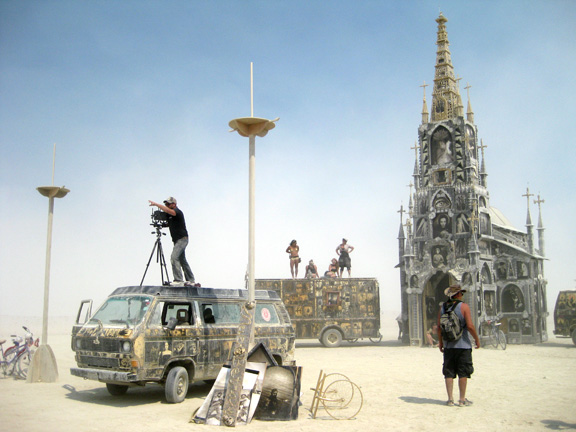




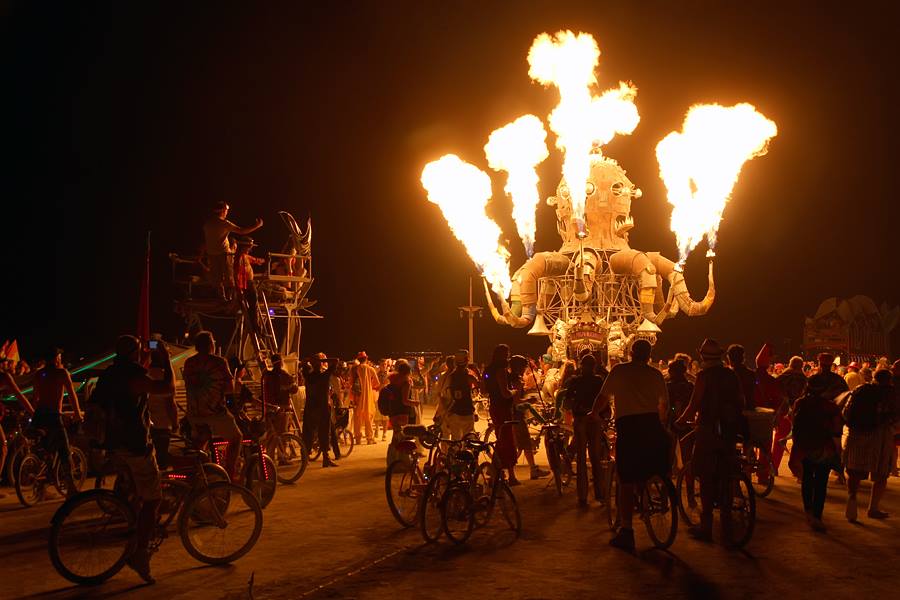




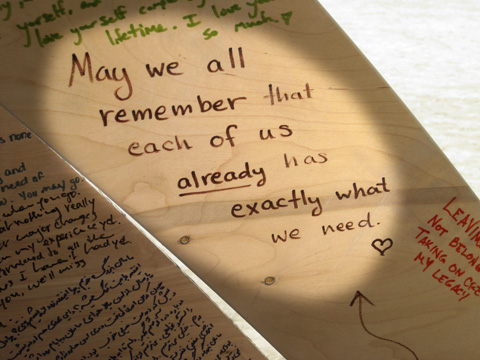



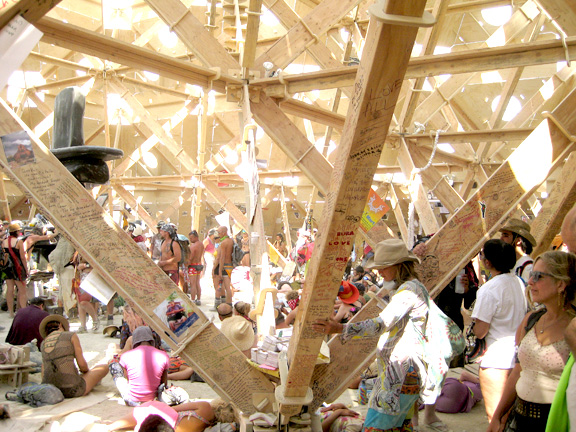



Leave a Reply
You must be logged in to post a comment.